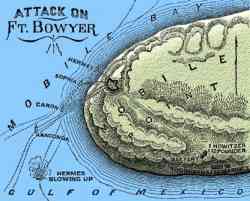First Battle of Fort Bowyer |
||
|---|---|---|
| Date | Wednesday, September 14, 1814 | |
| Weather | Hot and humid - 86 degrees | |
| Location | Fort Bowyer, Alabama (Gulf of Mexico) | |
British Empire |
United States |
|
| Belligerents | Native Americans, Spain, United Kingdom | The United States of America |
| Commanders | William Henry Percy | William T. Lawrence |
| Casualties |
Force: 830 Killed: 32 Wounded: 40 Captured: 0 |
Force: 120 Killed: 4 Wounded: 4 Captured: 0 |
|
ConstructionMobile had been a Spanish possession before the beginning of the war, but Congress had declared it part of American territory after commencement of the war. After Spanish forces evacuated Mobile in April 1813, the Americans built a redoubt on Mobile Point. In June 1813, Colonel John Bowyer completed the fort, but the Americans abandoned it about a year later. Then in August 1814, they garrisoned it again with 160 men under Maj. William Lawrence. The fort was made of sand and logs, and fan-shaped, with the curved face facing the ship channel into Mobile Bay. On the landward side there was abastion, flanked by two demi-bastions. The purpose of the fort was to impede any British invasion at this point on the Gulf Coast. OverviewThe British made two attacks on the Fort. The first, which failed, took place in September 1814. The second attack, in which the British were successful, took place in February 1815, after the Treaty of Ghent had been signed but before the news reached that part of America. BackgroundThe First Battle of Fort Bowyer in mid-September, CaptainWilliam Percy of the Royal Navy decided to attack Fort Bowyer in preparation for an assault on Mobile. He believed Bowyer to be a low, wooden battery mounting some six to 14 small caliber guns. Capturing the Fort would enable the British to move on Mobile and thereby block Louisiana's trade. From Mobile, the British could move overland to Natchez to cut off New Orleans from the north. Percy took with him HMS Hermes (22 guns), HMS Sophie (18 guns), HMS Carron (20 guns; Capt. Spencer), and either HMS Anaconda (18 guns) or HMS Childers (18 guns; Capt. Umphreville). On the morning of the 12th, Percy landed Lieut. Colonel Edward Nichols with a party of 130 Royal Marines, aided by a motley force of over 100 Spanish allies and around 600 native American allies, together with a 5½-inch howitzer, about 9 miles to the eastward.[11] [Note 2] The British land force then marched against the Fort, which was manned by 120 men from the 2nd U.S. Infantry under the command of Major William Lawrence. BattleThe battle began with the Americans repulsing the British land attack on 14 September. Nichols, ill at the time, was observing onHermes. On September 15, after contrary winds had died down, Percy crossed the bar with Hermes, Sophie, Carron, and Childersor Anaconda. The fort opened fire at 4:16 p.m. and at 4:30 Hermesopened fire. The U.S. fort and Hermes were at pistol-shot range. At 4:40, Sophie opened fire also, but the other two vessels were not able to get into a firing position. During the battle, a wooden splinter wounded Nichols in the eye. The British naval attack was unsuccessful. After two hours of fruitless bombardment, Hermes ran aground and lay helpless under the fire from the fort. Sophie's boats took off Hermes' crew and Percy set her on fire; she subsequently blew up after the fire reached her magazine. The remaining ships anchored for the night some one and half miles from the fort. AftermathThe next morning they re-crossed the bar and sailed away. Hermeshad lost 17 killed, 5 mortally wounded and 20 wounded, whileSophie had 6 killed and 16 wounded. In all, the British lost 32 killed and 40 wounded in the land and naval attacks, while the Americans lost only 4 killed and 4 wounded. A court-martial concluded that the circumstances had warranted the attack. The defeat at Fort Bowyer led the British to decide to attack New Orleans instead. After their defeat at the Battle of New Orleans, the British again decided to take Mobile. |
||
 Fort Bowyer was a fort the Americans erected on Mobile Point situated at the mouth of Mobile Bay. Built during the War of 1812, it no longer exists because in 1864 the US Government built Fort Morgan on the site. The fort was the site of two attacks by the British. The first, unsuccessful, attack led to the British changing their strategy and attacking New Orleans. The second attack, after their defeat at the Battle of New Orleans, was successful, but came after the end of the war.
Fort Bowyer was a fort the Americans erected on Mobile Point situated at the mouth of Mobile Bay. Built during the War of 1812, it no longer exists because in 1864 the US Government built Fort Morgan on the site. The fort was the site of two attacks by the British. The first, unsuccessful, attack led to the British changing their strategy and attacking New Orleans. The second attack, after their defeat at the Battle of New Orleans, was successful, but came after the end of the war.